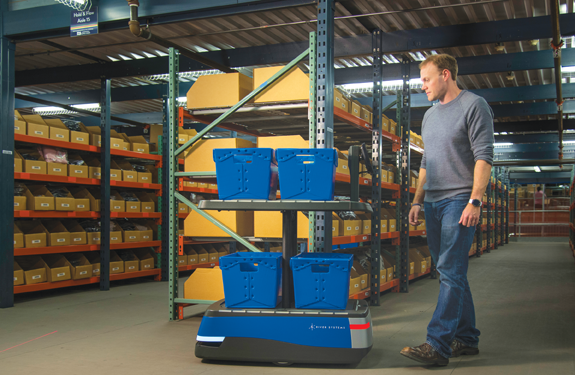Are robots an option for smaller companies?

by Howard Coleman
Wholesale-distributors looking to become leaner and execute flawlessly are recognizing a rapidly changing landscape, pushing many to consider investments in warehouse distribution operations to capture incremental efficiencies. The race is on, the clock is ticking, but you can’t keep throwing more labor or bigger carts at your business growth. I’d like to believe many will be proactive in pushing the right levers to adapt – and win – in this new landscape.
Gone are the days when robotics was confined to science fiction and bold predictions of the future. The last few years have seen a lot of buzz around robotics technology, specifically “cobots” (humans working alongside robots) to transport materials, address labor issues, control costs and drive efficiency, productivity and reliability. This comes at a time where there is an increasing need for logistics workers, driven by e-commerce, while at the same time experiencing a scarcity in the labor workforce.
Why is the case for robotics in distribution centers and warehouses becoming more obvious every day? Your warehouse associates are literally walking thousands of miles each year from one location to another. So, it’s time you need to understand robotics technology as a viable product transport solution. But, we do need to cut through the noise to see whether robotics can be implemented across industries. More specifically, can it be an option for smaller wholesale-distribution companies and, of course, what’s the ROI? Does it make financial as well as operational sense?
Several factors are influencing the robotics marketplace. 1) The concept of robotics-as-a-service (RaaS) is gaining popularity; the advantage of shifting a capital expenditure to an operational expenditure. 2) Another new breakthrough is the availability for autonomous robots to carry heavier payloads, even up to 3,000 lbs. 3) Companies find that there is less need for automation “fixed to the floor” so you can take a modular approach to acquisition, all resulting in lowered overall deployment costs.
So, if you’re considering a robotics project to seek answers and solutions to your materials handling needs (picking, receiving, put-away, and other product transport requirements) while reducing distribution transaction costs, the question becomes, where to begin? How do you minimize labor shortages, obtain higher through-puts and greater space utilization? It’s really all about delivering orders to their next destination both within your facilities and finally to your customer.
The answers, although sometimes nuanced, are out there. Investing in robotics can be perceived as a significant task, but much faster and simpler than you may have thought. If you are new to robotics you’ll need to create clear and complete specifications to ensure a successful project. Thinking through the basic requirements and capabilities required is a good place to start.
Finding the right robotics company to partner with – choosing an experienced and reputable partner – will be very important. Will automating with robots give you that edge?
We reached out to a handful of companies that provide robotics solutions to solicit their advice.
 6 River Systems
6 River Systems
Fergal Glynn
VP of Marketing
Over the last few years, there has been a rise in the use of automation and robotics to improve efficiencies and productivity in warehouses. Collaborative robots are becoming increasingly popular, in particular, because they do not replace the employee, but instead enhance the employee’s work and the surrounding environment. In fact, a recent study by McKinsey found that the market for industrial robots has grown 19 percent year-over-year since 2012, and will likely see double-digit growth through 2021 as companies continue to integrate the technology into their warehouses.
If distributors are reluctant to make large investments, they should seek out options that require minimal infrastructure changes. Many automation solutions today still require entire warehouses to be reconfigured and rewired to work properly, thus costing the distributor even more than a hardware investment. Autonomous mobile robots that employ technologies like AI and machine learning can typically be integrated into an existing warehouse seamlessly with no new organization or management system necessary since they can learn to navigate the floor and avoid obstacles on their own.
Another option for distributors that don’t want to make large capital investments is to find a provider that offers different financing options such as rentals.
All solutions provided by 6 River Systems have been designed to improve efficiencies and productivity within warehouses. They all integrate seamlessly with existing infrastructure and can accommodate other warehouse technologies like autobaggers, picking arms and more to optimize operations.
Chuck: Chuck is a mobile collaborative robot for picking and fulfillment tasks which communicates with the company’s existing warehouse management software (WMS) to coordinate all the tasks on warehouse floors. The result is a fleet of Chucks working seamlessly and collaboratively with associates to eliminate long walks, reduce in-aisle walking and speed up warehouse tasks, including put-away, picking, replenishment and sorting.
Mobile Sort: Mobile Sort enables warehouse operators to intelligently generate and fulfill batched orders. Mobile Sort stations consist of smart kiosks and mobile put-to-light walls with validation sensors that work with 6RS’ software and Chuck. Once an order is picked, Chuck delivers the totes to take-off points, where they are sorted into orders using the Mobile Sort stations.
Packout: Packout is a component of 6RS’ solution that manages order packing in tandem with Chucks to help operations achieve the greatest pick-to-pack throughput possible. Packout also contains auto-bagging capabilities, as provided by Accutech Packaging.
 Waypoint Robotics
Waypoint Robotics
Tim McCabe
Director - Business Development
We hear from many people including industrial distributors that they are having trouble attracting and retaining workers while the on-demand economy is putting more pressure on the efficiency of their operations. Many distributors are experiencing a higher volume of small batch orders that requires them to be flexible with a faster response rate. In other words, since they can’t hire, they need to equip their current workforce with better tools, like mobile robots for moving materials, that enable workers to meet the growing demands of the business.
Historically there haven’t been entry-level options for distributors that are reluctant to make major investments in robotics technology.
That is why companies have been slow to adopt. And we understand this. We founded Waypoint Robotics on the idea that robotics should be accessible to companies of all sizes and budgets. This starts with intuitive robots that are designed to be easy to deploy by the workforce without the need to change or add to existing infrastructure or operation. For example, our autonomous mobile robots can be set up and doing real work in 15 minutes without the need for an internet connection or a software subscription.
We offer autonomous mobile robots (AMRs) that workers can use to move parts, boxes and pallets from point to point so they can spend more time focused on value-add tasks. For example, our Vector, which holds up to 600 pounds, can be assigned the task to autonomously move material from picking to packaging and shipping areas. Our MAV3K can carry up to 3,000 pounds, which is perfect for transporting pallets between receiving, storage and pick area replenishing, with the added safety benefit of reducing forklift traffic within the facility.
 Fetch Robotics
Fetch Robotics
Stefan Nusser
VP of Product
We are seeing tremendous demand from companies that have never before considered robotics. Today’s industrial distributors are starting to demand more flexible solutions like autonomous mobile robots (AMRs) to support more agile workflows and supply chains. Over the past decade, the logistics industry has poured billions of dollars into fixed automation solutions, from conveyors to automatic storage and retrieval systems. While effective, these solutions are purpose-built for one workflow, which when set, cannot be easily modified, locking the supply chain’s operations.
Supply chains are under more pressure than ever before, as demands for speed, throughput and transparency continue to increase. Robots offer a proven way to increase productivity and visibility, but historically, investing in them was prohibitively costly — integrating robots in warehouses and supply chains meant massive up-front CapEx costs and lengthy installation times.
Fetch offers a Robots-as-a-Service (RaaS) model that enables brands to access robotics solutions with limited upfront cost and no setup time. Fetch’s AMR solutions give supply chain and manufacturing professionals the flexibility and infrastructure to meet the growing pressures they face in their day-to-day jobs from consumers while seeing immediate ROI. Once deployed, Fetch’s RaaS platform allows distributors to scale their operations effectively as the business grows.
Fetch’s cloud robotics platform offers solutions for a variety of industry use cases, from material transport to reverse logistics to inventory management.
Inventory management is a critical use case, as distribution and fulfillment centers stand to lose over a trillion dollars due to poor inventory management practices that result in lost or misplaced items. To remedy this, Fetch’s TagSurveyor is a cloud-based inventory management solution that improves inventory tracking, increases accuracy and saves warehouse managers’ time. The robot uses powerful RFID technology along with robot localization in a facility to gain a complete view of the warehouse and its assets. With the ability to autonomously and continuously capture RFID data, TagSurveyor allows distributors to fine-tune their inventory planning with more up to date and accurate data in order to operate leaner and more efficiently.
Furthermore, in order to thrive in today’s dynamic and ever changing market with increasing demand, labor shortages, shorter delivery windows and tightening margins, companies need the flexibility to change processes, workflows and facility layout without having to gut their facility and start back at square one. Fetch’s RollerTop solution enables companies to leverage as much of their investment in fixed automation as possible, while also introducing a more flexible and agile form of automation that can adjust to changes in business requirements. The robot does this by complementing sections of physical conveyor with a virtual conveyor, which in turn helps warehouse managers reclaim facility space that is being inefficiently used.
 Howard Coleman is principal of MCA Associates. Since 1986, the management consulting firm has worked with wholesale distribution and manufacturing companies that seek and are committed to operational excellence. Contact him at (203) 732-0603 or by email at hcoleman@mcaassociates.com.
Howard Coleman is principal of MCA Associates. Since 1986, the management consulting firm has worked with wholesale distribution and manufacturing companies that seek and are committed to operational excellence. Contact him at (203) 732-0603 or by email at hcoleman@mcaassociates.com.
This article originally appeared in the March/April 2020 issue of Industrial Supply magazine. Copyright 2020, Direct Business Media.












